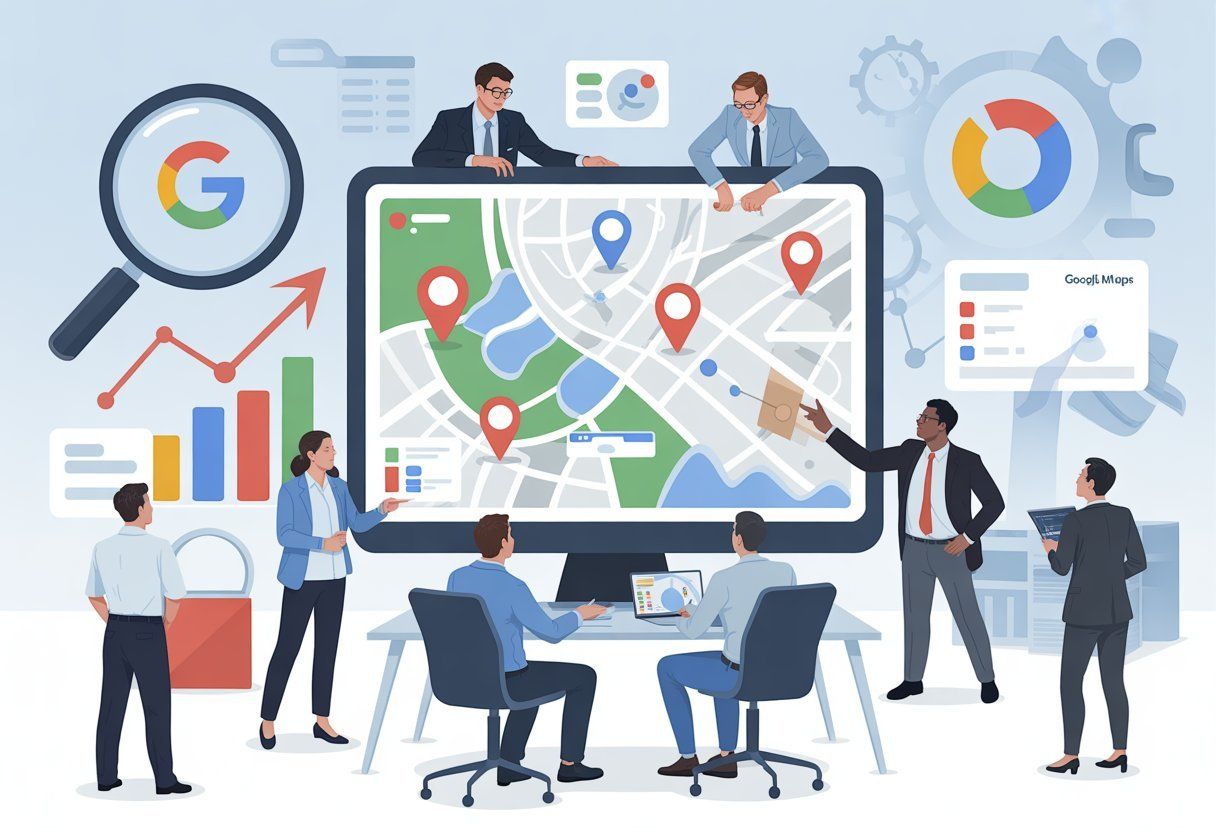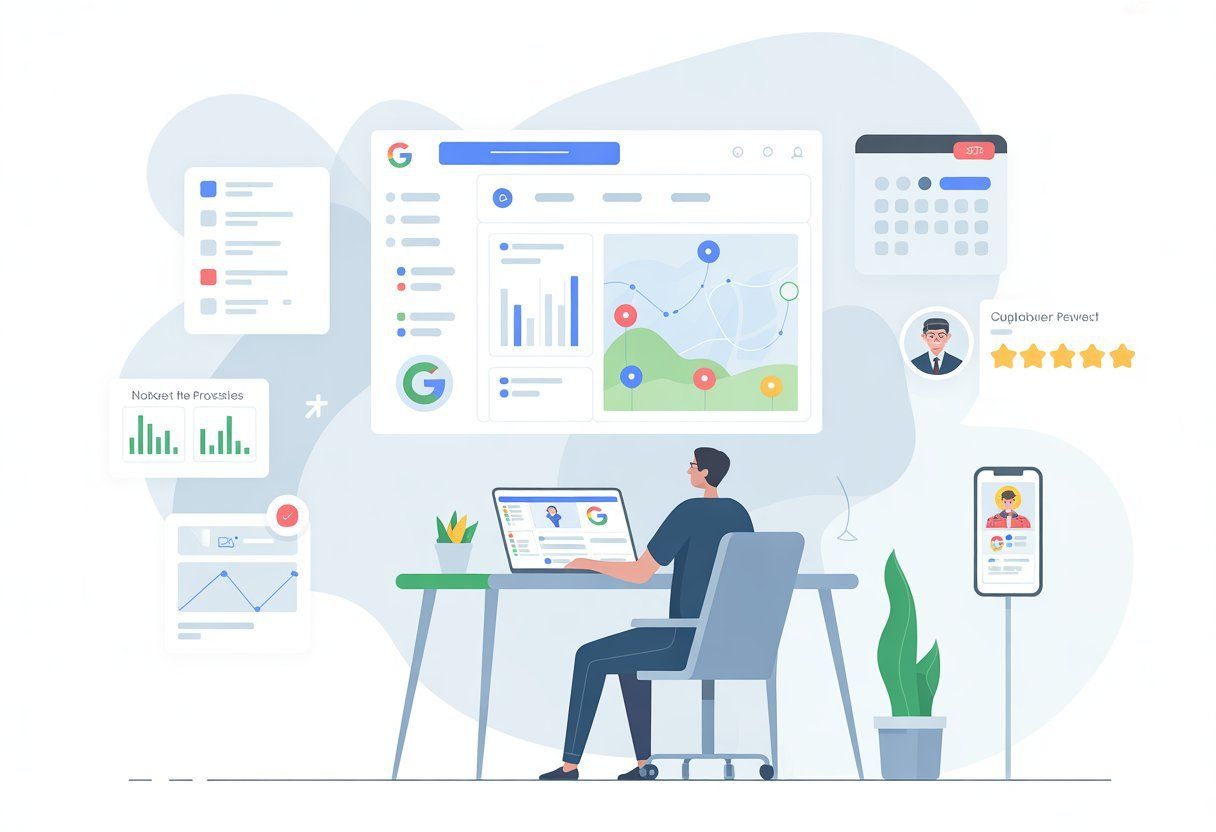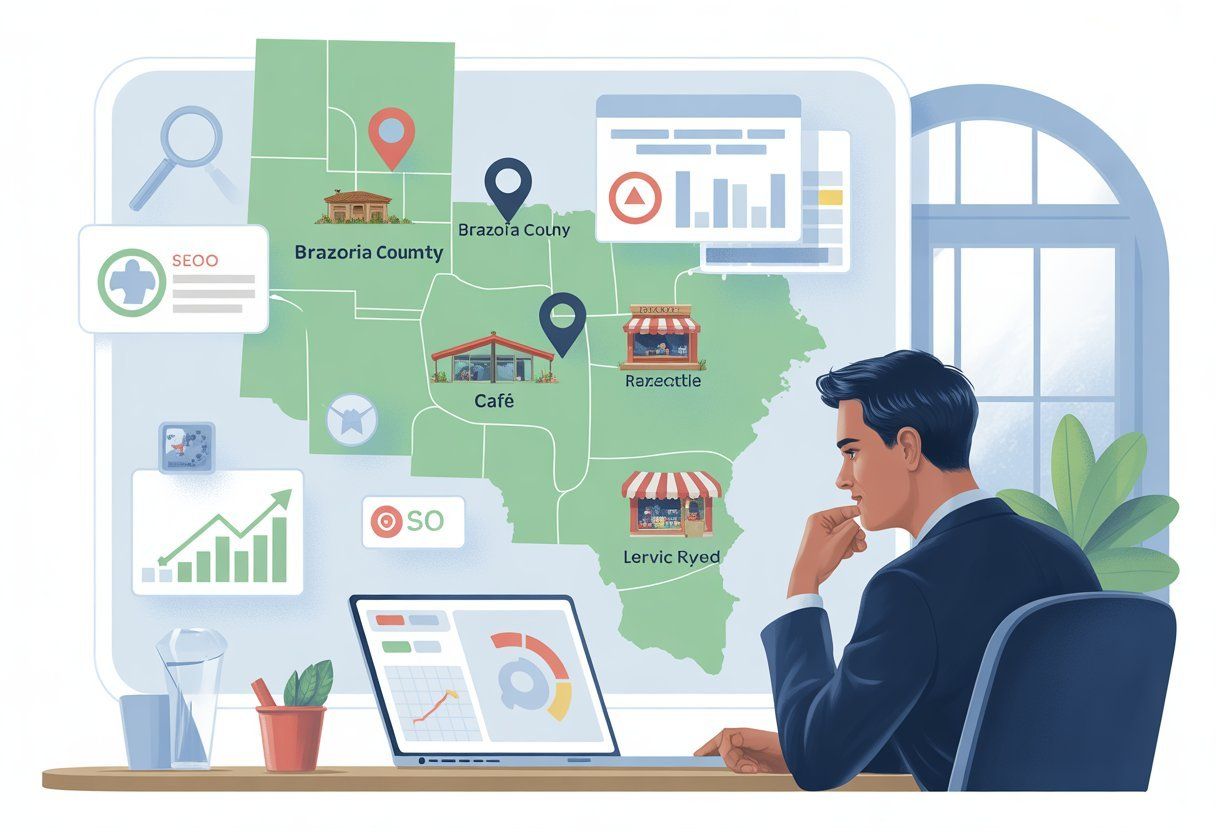SEO My Website Guru SEO Blog
By contact • September 11, 2025

Your business needs customers to find you. Google Maps has become the main way people discover local businesses.
When someone searches for a product or service near them, your Google Maps listing is often the first thing they see. This simple listing can make or break whether a potential customer chooses your business.

Google Maps now works as your 24/7 digital storefront that shows customers everything they need to know before they visit. Your listing displays your hours, photos, reviews, and contact info all in one spot.
People can see your storefront, read what others say about you, and decide if they want to visit without ever calling or going to your website.
Most customers check Google Maps before they shop or eat somewhere new. They look at your star rating, read recent reviews, and check if you’re open.
If your listing looks good and has positive reviews, you’re more likely to get their business. A strong Google Maps presence builds trust and brings in customers even when you’re not actively marketing.
Key Takeaways
- Google Maps listings act as your primary digital storefront where customers first learn about your business.
- A well-maintained Google Maps presence builds customer trust and drives more foot traffic to your location.
- Optimizing your Google Maps listing with accurate information and positive reviews directly impacts your business growth.
Why Google Maps Is Your New Digital Storefront
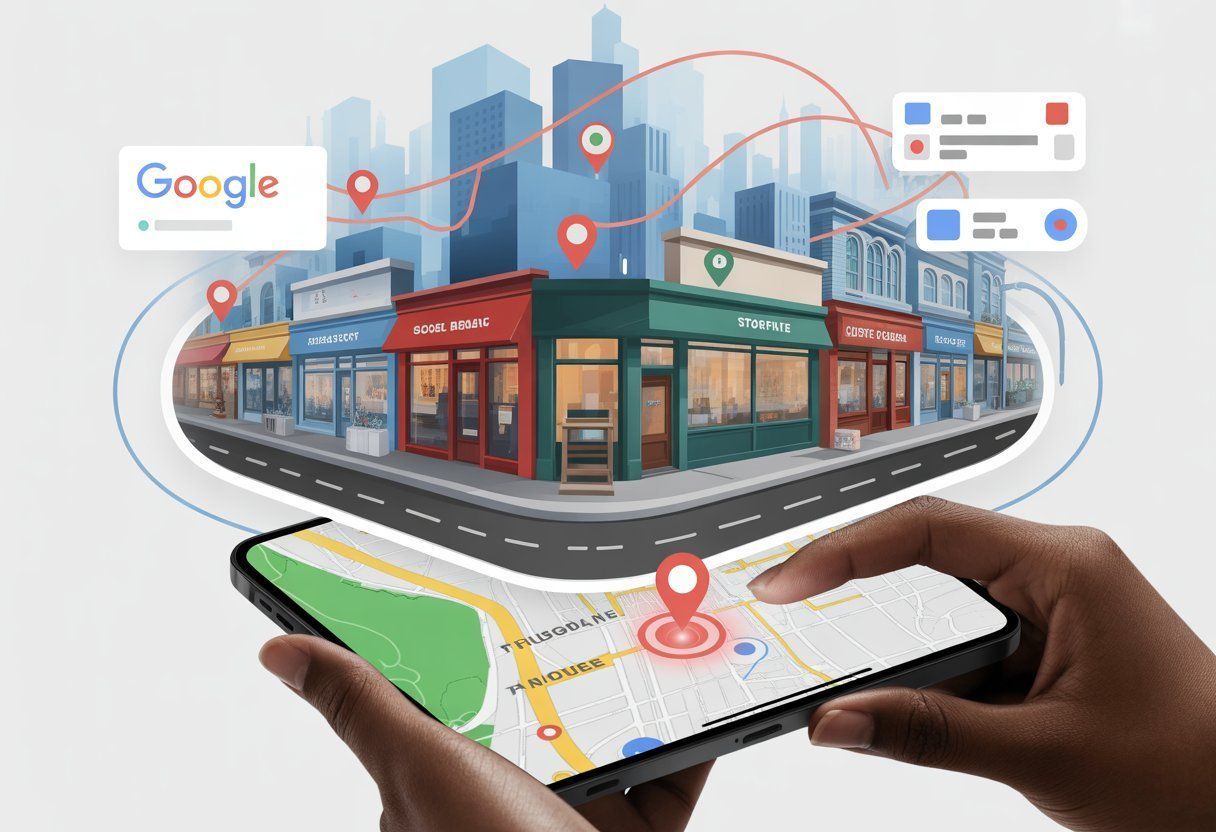
Google Maps has transformed from a simple navigation tool into the primary way customers discover and evaluate local businesses. Your Google Maps business listing now serves as your digital storefront, influencing customer decisions before they ever step foot in your location.
The Rise of Online Local Search
Local search has become the dominant way customers find businesses. 97% of people search online to find local companies, and most of these searches happen on mobile devices.
When customers search for services like “restaurant near me” or “auto repair shop,” Google Maps results appear at the top of search results. This placement makes your Google Maps listing more visible than your website in many cases.
Voice search has made local search even more important. People ask their phones and smart speakers to find nearby businesses.
These voice searches almost always pull results from Google Maps data. The shift to mobile-first browsing means customers expect instant access to your business info.
They want your address, phone number, hours, and reviews without having to dig through multiple websites.
First Impressions: Your Google Maps Business Profile
Your Google My Business profile is often the first interaction customers have with your brand. This profile acts as your digital storefront window, displaying crucial information that influences purchasing decisions.
A complete business profile includes:
- Business name and category
- Address and phone number
- Hours of operation
- Website link
- Photos of your business
- Customer reviews and ratings
Photos play a huge role in attracting customers. Businesses with photos receive 42% more requests for directions and 35% more click-throughs to their websites than those without images.
Your business description should clearly explain what you offer and what makes you different. Keep it simple and focus on the services customers search for most.
Visibility in the Local Pack and Google Search
The Local Pack shows the top three Google Maps results for local searches. Getting into this space dramatically increases your visibility and foot traffic.
Google ranks businesses in the Local Pack based on three main factors:
| Factor | What It Means |
|---|---|
| Relevance | How well your business matches the search |
| Distance | How close you are to the searcher |
| Prominence | Your overall online reputation and authority |
Local SEO helps improve your rankings in these results. This includes keeping your business information consistent across all online directories and encouraging customer reviews.
Your Google Maps listing also appears in regular Google search results. When someone searches for your business name, your Maps listing often shows up alongside your website in the search results.
Influence on Customer Behavior and Experience
Google Maps shapes how customers interact with your business at every stage of their journey. Most customers check your Maps listing before visiting, calling, or making purchases.
Customer reviews on Google Maps heavily influence buying decisions. Businesses with higher ratings and more positive reviews attract more customers and generate more revenue.
The “Questions & Answers” feature lets potential customers ask questions about your business directly on your Maps listing. Quick responses to these questions improve customer experience and show you care about service.
Mobile users rely on Google Maps for directions, hours, and contact information. A well-maintained listing makes it easy for customers to find and contact you when they’re ready to buy.
Call tracking shows that businesses receive more phone calls when their Google Maps information is accurate and complete. Many customers prefer calling directly from the Maps listing rather than visiting websites.
Why Hire a Google Maps SEO Agency for Better Rankings
Managing your Google Maps presence requires ongoing attention and expertise. Local SEO agencies understand the specific factors that improve Google Maps rankings.
Professional agencies can help with:
- Optimizing your business profile for better visibility
- Managing and responding to customer reviews
- Building local citations across online directories
- Creating location-specific content for your website
Agencies also monitor your online reputation and help resolve issues that could hurt your rankings. They track your performance and adjust strategies based on what works for your specific market.
The time investment needed to properly manage Google Maps SEO often exceeds what busy business owners can handle. Agencies have tools and processes that make optimization more efficient and effective.
Working with specialists often produces better results than DIY approaches because Google’s local search algorithm changes frequently and requires constant adaptation.
Optimizing and Leveraging Your Google Maps Presence
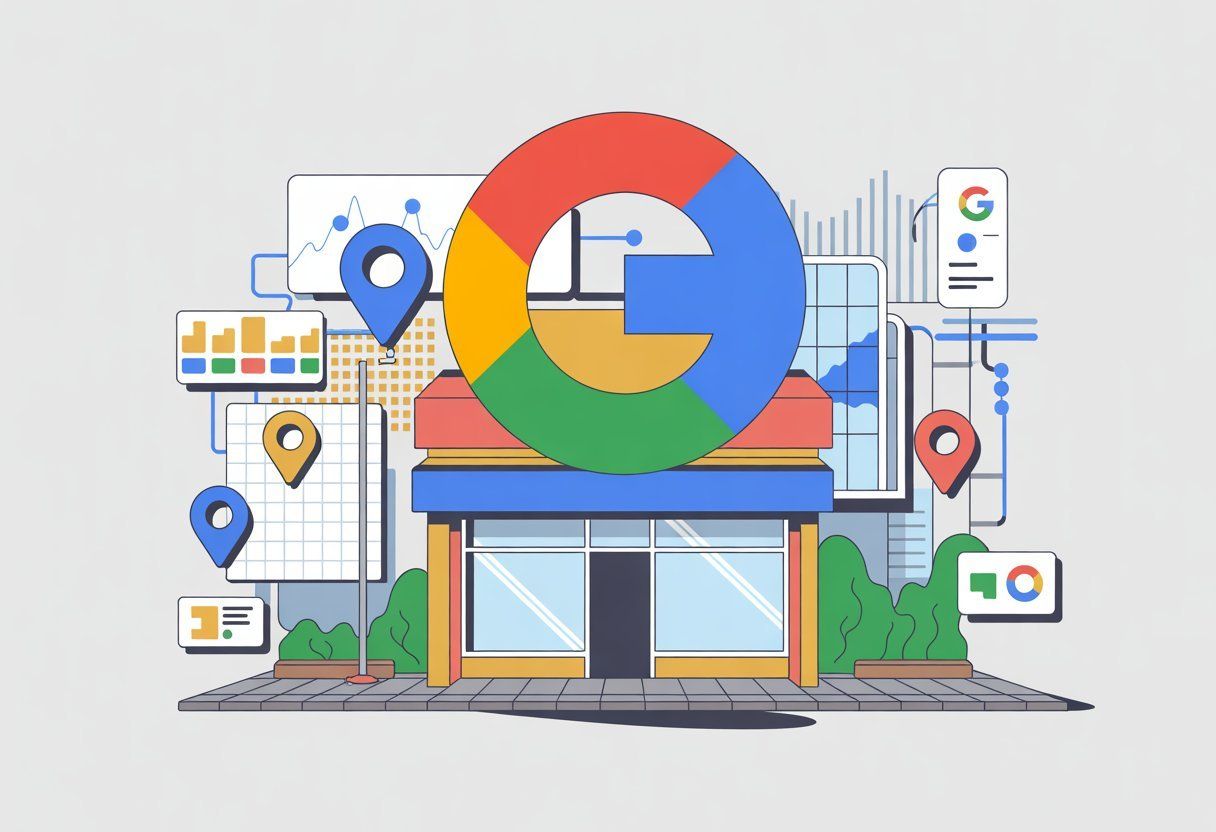
Your Google Maps presence needs strategic optimization across four key areas: claiming your business profile, maintaining accurate information, engaging through reviews and posts, and using data insights to improve performance.
Setting Up and Claiming Your Google My Business Listing
Your Google Business Profile serves as the foundation of your Maps presence. Start by visiting the Google My Business website and searching for your business name.
If your business appears in search results, click “Claim this business.” If not, select “Add your business to Google.”
Complete the verification process :
- Choose phone, postcard, or email verification
- Follow Google’s instructions exactly
- Wait for verification before making major changes
Select your primary business category carefully. This choice affects which searches trigger your listing.
Choose the most specific category that matches your main service. Add secondary categories to capture additional search queries.
A restaurant might add “Italian restaurant” as primary and “pizza delivery” as secondary. Essential setup steps:
- Upload your business logo and cover photo
- Add your complete business address
- Enter accurate phone numbers
- Set your service areas if you serve customers at their locations
- Include your website URL
Managing NAP, Hours, and Business Description
NAP consistency across all platforms directly impacts your Google Maps ranking. Your name, address, and phone number must match exactly on your website, social media, and directory listings.
Update your hours of operation regularly. Include holiday hours and temporary changes.
Customers who find closed businesses during listed hours often leave negative reviews. Write an effective business description:
- Use 150-200 words maximum
- Include your main keywords naturally
- Mention your services and specialties
- Add your location and service areas
- Highlight what makes you different
Your description should read naturally while including terms customers search for. A dental office might mention “teeth cleaning, dental implants, and emergency dentist services in downtown Portland.”
Keep all information current. Google rewards businesses that maintain fresh, accurate data with better visibility in search results.
Harnessing Customer Reviews and Google Posts
Customer reviews significantly impact your Maps ranking and customer trust. The number of reviews and your overall rating both influence where you appear in search results.
Encourage review generation:
- Ask satisfied customers directly
- Send follow-up emails with review links
- Create QR codes linking to your review page
- Train staff to request reviews
Respond to all reviews within 48 hours. Thank positive reviewers and address negative feedback professionally.
Your responses show future customers how you handle problems. Google Posts let you share updates directly on your Maps listing.
These posts appear prominently and can drive customer actions. Effective Google Posts include:
- New product announcements
- Special offers and promotions
- Upcoming events or webinars
- Behind-the-scenes content
- Customer testimonials
Post weekly to keep your listing active. Include clear calls-to-action like “Call now” or “Visit website” to encourage customer engagement.
Using Google Maps Insights to Drive Engagement
Google My Business Insights provides valuable data about how customers find and interact with your listing. Check these metrics weekly to spot improvement opportunities.
Key metrics to monitor:
- How customers search for you (direct vs. discovery searches)
- Actions taken (website visits, direction requests, phone calls)
- Popular times when customers visit
- Photo views and engagement
Discovery searches indicate people finding you while searching for general terms like “restaurants near me.” High discovery numbers suggest strong category optimization.
If customers frequently request directions, make sure your address is accurate and easy to find. If they visit your website often, make sure it loads quickly on mobile devices.
Use popular times data to schedule staff and inventory. Post special offers during slower periods to drive traffic.
Track which photos get the most views. Upload similar content to increase engagement.
Customer photos often perform better than professional shots, so encourage customers to share their experiences.
Frequently Asked Questions
Google Maps has become a critical tool for businesses to connect with local customers and build trust through accurate information, reviews, and visual content.
Learning how to use this platform effectively can really impact your customer acquisition and retention. It’s worth the effort, even if it sometimes feels like a moving target.
How does Google Maps influence a business’s online visibility?
Google Maps shapes how people find your business when they search locally. Your Google Business Profile really decides if you show up in those results.
Your listing pops up in both Google Maps and regular Google searches. That means you’ve got two chances to get in front of potential customers.
When you fill out your profile with photos, reviews, and accurate details, you usually rank higher. Google’s algorithm seems to prefer businesses that share more about what they do and where they’re located.
Local searches usually lead to quick action. Folks who spot you on Google Maps are often ready to call, visit, or even buy right away.
What role does Google Maps play in a customer’s decision-making process?
For most local customers, Google Maps is the first thing they see. Your business profile shows hours, location, and your phone number before anyone even checks out your website.
Customer reviews on your listing can make or break a decision. People read those reviews to get a feel for your quality and reliability.
Photos help customers picture your business. Shots of your storefront or products can boost their confidence and set some expectations.
The Questions & Answers section lets people ask about your business directly. If you answer quickly, you might just sway them to visit.
What are the benefits of optimizing your Google Maps listing for search results?
When you optimize your listing, you usually get more visibility in local searches. Listings with keywords, photos, and regular updates tend to rank better.
Google’s analytics give you helpful customer insights. You can see how people find you and what they do next.
Getting your listing verified builds trust. That little badge tells folks your business is legit and managed well.
Keeping your profile active with fresh content helps you stay ahead of local competitors. Businesses that update often usually outrank those that don’t bother.
How can businesses leverage Google Maps features to attract more customers?
Google Posts let you share updates, promos, or events right on your listing. When customers check your profile, these posts catch their eye.
The messaging feature lets you chat with potential customers directly. Fast replies can turn a search into a sale.
Product and service catalogs show what you offer without making people visit your website. Customers can see your stuff right from your listing.
Attributes like “wheelchair accessible” or “free Wi-Fi” help people find exactly what they need. These tags make your business stand out in the right searches.
What are the best practices for maintaining an up-to-date Google Maps business profile?
Update your business hours as soon as they change. Wrong hours frustrate customers and might even lead to negative reviews.
Add new photos now and then to keep your profile looking fresh. Recent pics of your products or events show you’re active.
Try to respond to all customer reviews within a few days. Professional replies, whether the feedback’s good or bad, show you care about customer service.
Keep an eye on the Questions & Answers section for new questions. Quick, accurate answers help stop confusion and show you’re on top of things.
Check your business info every month to make sure it’s right. Double-check your address, phone, and website links so nothing’s broken.
How can integrating Google Maps with my business website improve user experience?
When you embed Google Maps on your website, customers can find your location without any hassle. Clear directions mean fewer missed appointments—always a plus.
Adding maps to your location pages gives your local SEO a nice boost. Search engines seem to like websites that show exactly where you are.
Mobile users love being able to tap for directions straight from your site. That quick, no-fuss experience really smooths out the customer journey.
If you’ve got more than one location, maps help people pick the branch closest to them. Interactive maps make comparing spots and services pretty straightforward.
The post Why Google Maps Is Now Your Digital Storefront: Essential Guide appeared first on SEO My Website Guru.
Insights to fuel your marketing business
Sign up to get industry insights, trends, and more in your inbox.
Contact Us
We will get back to you as soon as possible.
Please try again later.
SHARE THIS
Latest Posts
